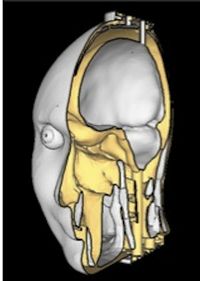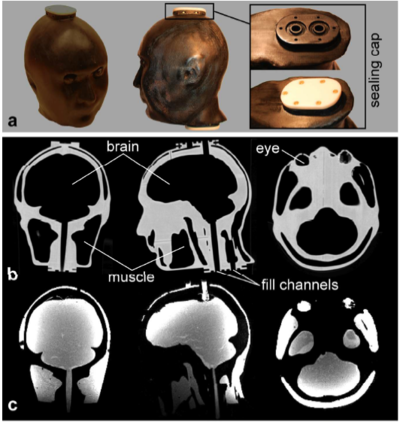Difference between revisions of "MGH head 1:MGH head 1"
Jump to navigation
Jump to search
| Line 7: | Line 7: | ||
[http://www.ncbi.nlm.nih.gov/pubmed/18985401 MRI-based anatomical model of the human head for specific absorption rate mapping. | [http://www.ncbi.nlm.nih.gov/pubmed/18985401 MRI-based anatomical model of the human head for specific absorption rate mapping. | ||
| − | + | *We have taken this anatomically labeled head from a pixel model to a mesh model and created a phantom with 2 fluid compartments; 1) brain, and 2) other soft tissues (see figure below). The idea is that materials that are electrically similar are grouped together. Thus bone and air (both low epsilon, low conductivity) are done in plastic (also low e, low conductivity), and the tissue compartments can be filled with appropriate fluids. Also shown on the figure below is a CT scan of the phantom and an MRI of the filled phantom. | |
[https://gate.nmr.mgh.harvard.edu/wiki/Phantoms/images/MGH_head_1.zip Click here for .skp and stl files] to download files for the anthropomorthic head phantom published in Graedel et al MRM 2014. | [https://gate.nmr.mgh.harvard.edu/wiki/Phantoms/images/MGH_head_1.zip Click here for .skp and stl files] to download files for the anthropomorthic head phantom published in Graedel et al MRM 2014. | ||
| Line 13: | Line 13: | ||
'''3D printing tips''' | '''3D printing tips''' | ||
| − | + | *Be sure to see our info on the first page concerning sealing phantoms created by addive technology 3D printers. Normally these are porous and do not hold water; they need a sealing step. | |
[[File:Phantom_figure_CT_MR.png|400px|thumb|right|]] | [[File:Phantom_figure_CT_MR.png|400px|thumb|right|]] | ||
Revision as of 15:19, 23 December 2013
MGH head 1
- This is a head phantom based on a 1mm isotropic resolution MR dataset which was anatomically segmented and used as a numerical model for electromagnetics calculations as described in:
Makris et al.
[http://www.ncbi.nlm.nih.gov/pubmed/18985401 MRI-based anatomical model of the human head for specific absorption rate mapping.
- We have taken this anatomically labeled head from a pixel model to a mesh model and created a phantom with 2 fluid compartments; 1) brain, and 2) other soft tissues (see figure below). The idea is that materials that are electrically similar are grouped together. Thus bone and air (both low epsilon, low conductivity) are done in plastic (also low e, low conductivity), and the tissue compartments can be filled with appropriate fluids. Also shown on the figure below is a CT scan of the phantom and an MRI of the filled phantom.
Click here for .skp and stl files to download files for the anthropomorthic head phantom published in Graedel et al MRM 2014.
3D printing tips
- Be sure to see our info on the first page concerning sealing phantoms created by addive technology 3D printers. Normally these are porous and do not hold water; they need a sealing step.

